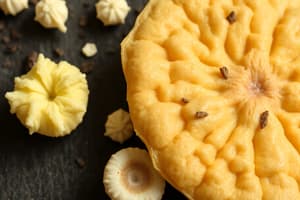Podcast
Questions and Answers
What is the primary structural form of fungi that grows as large single cells?
What is the primary structural form of fungi that grows as large single cells?
Which of these habitats is NOT typically associated with yeasts?
Which of these habitats is NOT typically associated with yeasts?
Which feature distinguishes moulds from yeasts?
Which feature distinguishes moulds from yeasts?
What type of oxygen conditions can yeasts grow in?
What type of oxygen conditions can yeasts grow in?
Signup and view all the answers
What characteristic best describes the appearance of moulds?
What characteristic best describes the appearance of moulds?
Signup and view all the answers
Which health risk is associated with yeast infections?
Which health risk is associated with yeast infections?
Signup and view all the answers
Which of the following is a true statement about the spore characteristics of yeasts?
Which of the following is a true statement about the spore characteristics of yeasts?
Signup and view all the answers
What defines the filamentous structure of moulds?
What defines the filamentous structure of moulds?
Signup and view all the answers
Study Notes
Fungi Characteristics
- Fungi are eukaryotic organisms.
- Candida is a significant fungus in dentistry.
- Fungi exist in two main structural forms: yeast and mold.
- Some fungi are dimorphic, meaning they can exist as both yeast and mold.
Yeast Characteristics
- Grows as large, single cells (unicellular).
- Very common habitat: fruit, mammalian stomachs, oral cavities, and vaginal areas.
- Appearance: white, thready, usually oval.
- Does not have true hyphae; instead, forms multicellular structures called pseudohyphae.
- Not a sporing species.
- Less colorful than molds; colorless to collectively yellow-creamy.
- Can grow aerobically and anaerobically.
- Can cause infection in immunocompromised individuals.
- Often exhibits lateral projections (daughter cells) budding from the mother cell.
- Some reproduce by binary fission.
- Forms pseudohyphae (chains of elongated budding cells) in the oral cavity (e.g., Candida).
Mold Characteristics
- Grows as multiple tubular branches (multicellular).
- Typically found in damp, dark, or humid environments.
- Fluffy appearance with various shapes.
- Contains microscopic filaments called hyphae.
- Is a sporing fungus.
- Very colorful; can be orange, green, black, brown, pink, or purple.
Studying That Suits You
Use AI to generate personalized quizzes and flashcards to suit your learning preferences.
Related Documents
Description
This quiz explores the distinct characteristics of fungi, focusing on their structural forms: yeast and mold. It covers their habitats, reproduction methods, and significance in various fields, particularly dentistry. Test your knowledge on these fascinating eukaryotic organisms.




